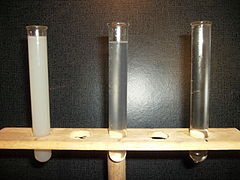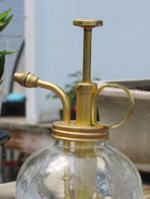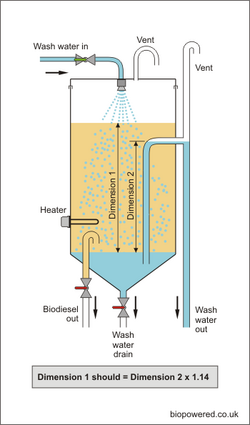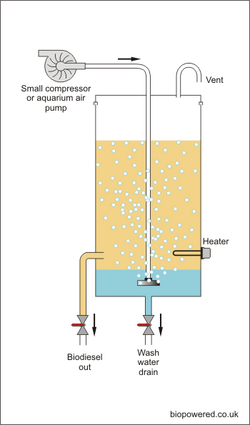Difference between revisions of "Water washing"
(→Basic wash tank) |
|||
| Line 27: | Line 27: | ||
==GL wash tank== | ==GL wash tank== | ||
| − | |||
[[File:GL wash tank.png|250px|thumb|left|'GL never overflowing' wash tank.]] | [[File:GL wash tank.png|250px|thumb|left|'GL never overflowing' wash tank.]] | ||
| − | + | [[File:Modified ballcock.png|150px|thumb|right|Detail of how a ballcock can be modified to prevent wash tanks overflowing.]] | |
| − | |||
| − | |||
| − | |||
| − | |||
| − | |||
| − | |||
| − | |||
| − | |||
| − | |||
| − | |||
| − | + | Originally designed by [[Graham Laming]] and dubbed 'The never overflowing wash tank’, this design automatically drains the same volume of water as is being introduced. | |
| + | |||
| + | The simple layout keeps the level in the tank fixed. As you add water via a mist head, it passes through the biodiesel, taking methanol, soap and glycerol with it, and then collects in the bottom of the tank, where it is forced up the overflow pipe, by the weight of biodiesel on top of it, to drain off as much water as is added. The vent on the overflow pipe prevents the arrangement from siphoning uncontrollably. | ||
| + | |||
| + | The biodiesel outlet tube on the left is bent over with a 180° return bend plumbing fitting, to prevent water from entering the biodiesel drain pipe during washing. | ||
| + | |||
| + | The tank should be filled with water first, to about ½ way between the biodiesel drain tube and the bottom of the tank. This should be around 15% of the tank capacity. The Biodiesel can the be added and washing can commence as above | ||
| + | This system will work so long as the wash water can freely pass through the overflow tube. Therefore, do not use this system in winter, where freezing of either the biodiesel or the water may occur. Use a large bore drain pipe to minimise the risk of it becoming blocked. | ||
| + | As an added line of safety a ballcock or float valve can be added to the water supply. This will be mounted in the side of the tank in the usual way so that it closes and shuts off the wash water before the tank overflows. It will require modifying so that the outlet has a pipe attached which runs to the misting head. The old brass ballcocks are most easily modified in this manner. | ||
<br> | <br> | ||
Revision as of 23:03, 5 January 2011
Water washing is a way to remove soap and other contaminants from reacted biodiesel. Typically this involves mist spraying water over the biodiesel, or bubbling air through water with the biodiesel floating on top.
Water washing is a different process to water prewash which is a form of water washing carried out in the processor before the glycerol is drained off.
Even the best quality Biodiesel will contain some level of contaminants. Many of these are water soluble such as soaps, Glycerol, Methanol and catalyst. Water washing removes these contaminants quite effectively however it leaves the Biodiesel containing trace amounts of water which needs to be removed by an additional drying process. Water washing should ideally be performed around 18 hours after the glycerol is drained. This gives the bulk of contaminants time to settle out and makes the job of washing easer and quicker. It is preferable that this settling is carried out in a separate tank with the Biodiesel then being transferred to a wash tank for the washing process.
Basic mist washing tank
Mist washing, as the name implies, comprises spraying a very fine water mist on to the top of the Biodiesel and letting it fall, in minute droplets, to the bottom of the tank collecting soluble contaminants on the way.
Provided the spray is fine enough, mist washing is the least likely washing process to create an emulsion. There are numerous spray nozzles available from industrial suppliers, but home brewers have had great success by using nozzles from garden sprayers and plant misting systems. Hand held sprayers with glass reservoirs and brass fittings are easily adapted by cutting the off the brass pipe and soldering it to the wash tank water supply pipe work.
Start with a low pressure and very fine spray pattern, slowly increasing the pressure and flow as washing proceeds. This gives the water a chance to dissolve the soaps and Glycerol and carry them to the bottom of the tank without forming an emulsion.
Mist washing generally takes 6 - 8 hours and with the set up shown left; the water should be periodically drained to prevent the tank from overflowing. The wash water drain valve can be cracked open to allow a continual outlet for the water, but care should be taken that the tank doesn’t drain to a point were the Biodiesel is lost. From this point of view a ‘GL wash tank’ is a far better arrangement and is shown below.
Towards the end of the washing samples should be ten and a 50/50 soap test made to determine if the washing is complete. Once a satisfactory result has been achieved, washing can stop. It’s worth noting that the Biodiesel may well look cloudy at this stage.
If reacted completely and washed thoroughly, Biodiesel should clear within a matter of hours after washing. This is not necessarily and indication that it’s dry so the Biodiesel should be heated to around 50 – 60°C for a couple of hours. To aid this process a bubbler supplied from an aquarium air pump can be placed in the tank. Any water that has dropped out during this process should be drained off.
GL wash tank
Originally designed by Graham Laming and dubbed 'The never overflowing wash tank’, this design automatically drains the same volume of water as is being introduced.
The simple layout keeps the level in the tank fixed. As you add water via a mist head, it passes through the biodiesel, taking methanol, soap and glycerol with it, and then collects in the bottom of the tank, where it is forced up the overflow pipe, by the weight of biodiesel on top of it, to drain off as much water as is added. The vent on the overflow pipe prevents the arrangement from siphoning uncontrollably.
The biodiesel outlet tube on the left is bent over with a 180° return bend plumbing fitting, to prevent water from entering the biodiesel drain pipe during washing.
The tank should be filled with water first, to about ½ way between the biodiesel drain tube and the bottom of the tank. This should be around 15% of the tank capacity. The Biodiesel can the be added and washing can commence as above This system will work so long as the wash water can freely pass through the overflow tube. Therefore, do not use this system in winter, where freezing of either the biodiesel or the water may occur. Use a large bore drain pipe to minimise the risk of it becoming blocked.
As an added line of safety a ballcock or float valve can be added to the water supply. This will be mounted in the side of the tank in the usual way so that it closes and shuts off the wash water before the tank overflows. It will require modifying so that the outlet has a pipe attached which runs to the misting head. The old brass ballcocks are most easily modified in this manner.




